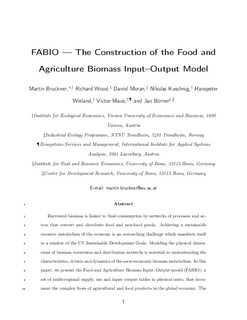| dc.contributor.author | Bruckner, Martin | |
| dc.contributor.author | Wood, Richard | |
| dc.contributor.author | Moran, Daniel | |
| dc.contributor.author | Kuschnig, N | |
| dc.contributor.author | Wieland, Hanspeter | |
| dc.contributor.author | Maus, Viktor | |
| dc.contributor.author | Borner, Jan | |
| dc.date.accessioned | 2019-11-21T12:20:08Z | |
| dc.date.available | 2019-11-21T12:20:08Z | |
| dc.date.created | 2019-09-23T14:28:40Z | |
| dc.date.issued | 2019 | |
| dc.identifier.citation | Environmental Science and Technology. 2019, 53 11302-11312. | nb_NO |
| dc.identifier.issn | 0013-936X | |
| dc.identifier.uri | http://hdl.handle.net/11250/2629794 | |
| dc.description.abstract | Harvested biomass is linked to final consumption by networks of processes and actors that convert and distribute food and nonfood goods. Achieving a sustainable resource metabolism of the economy is an overarching challenge which manifests itself in a number of the UN Sustainable Development Goals. Modeling the physical dimensions of biomass conversion and distribution networks is essential to understanding the characteristics, drivers, and dynamics of the socio-economic biomass metabolism. In this paper, we present the Food and Agriculture Biomass Input–Output model (FABIO), a set of multiregional supply, use and input–output tables in physical units, that document the complex flows of agricultural and food products in the global economy. The model assembles FAOSTAT statistics reporting crop production, trade, and utilization in physical units, supplemented by data on technical and metabolic conversion efficiencies, into a consistent, balanced, input–output framework. FABIO covers 191 countries and 130 agriculture, food and forestry products from 1986 to 2013. The physical supply use tables offered by FABIO provide a comprehensive, transparent, and flexible structure for organizing data representing flows of materials within metabolic networks. They allow tracing of biomass flows and embodied environmental pressures along global supply chains at an unprecedented level of product and country detail and can help to answer a range of questions regarding environment, agriculture, and trade. Here we apply FABIO to the case of cropland footprints and show the evolution of consumption-based cropland demand in China, the E.U., and the U.S.A. for plant-based and livestock-based food and nonfood products. | nb_NO |
| dc.language.iso | eng | nb_NO |
| dc.publisher | American Chemical Society | nb_NO |
| dc.title | FABIO – The Construction of the Food and Agriculture Biomass Input-Output Model | nb_NO |
| dc.type | Journal article | nb_NO |
| dc.type | Peer reviewed | nb_NO |
| dc.description.version | acceptedVersion | nb_NO |
| dc.source.pagenumber | 11302-11312 | nb_NO |
| dc.source.volume | 53 | nb_NO |
| dc.source.journal | Environmental Science and Technology | nb_NO |
| dc.identifier.doi | 10.1021/acs.est.9b03554 | |
| dc.identifier.cristin | 1727902 | |
| dc.relation.project | Norges forskningsråd: 255483 | nb_NO |
| dc.description.localcode | Locked until 3.9.2020 due to copyright restrictions. This document is the Accepted Manuscript version of a Published Work that appeared in final form in [JournalTitle], copyright © American Chemical Society after peer review and technical editing by the publisher. To access the final edited and published work see https://doi.org/10.1021/acs.est.9b03554 | nb_NO |
| cristin.unitcode | 194,64,25,0 | |
| cristin.unitname | Institutt for energi- og prosessteknikk | |
| cristin.ispublished | true | |
| cristin.fulltext | postprint | |
| cristin.qualitycode | 2 | |
